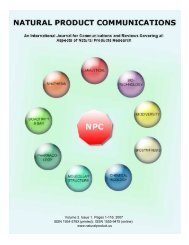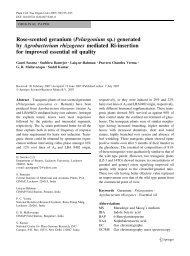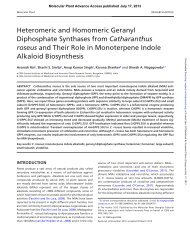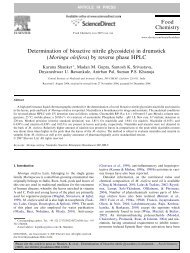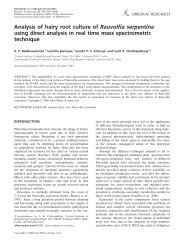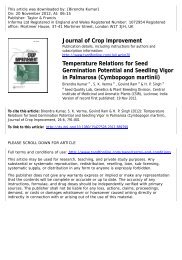Ocimum basilicum L. - CIMAP Staff - Central Institute of Medicinal ...
Ocimum basilicum L. - CIMAP Staff - Central Institute of Medicinal ...
Ocimum basilicum L. - CIMAP Staff - Central Institute of Medicinal ...
You also want an ePaper? Increase the reach of your titles
YUMPU automatically turns print PDFs into web optimized ePapers that Google loves.
This article was downloaded by: [<strong>CIMAP</strong> <strong>Central</strong> <strong>Institute</strong> <strong>of</strong> <strong>Medicinal</strong> & Aromatic Plants],[Birendra Kumar]On: 06 August 2012, At: 01:56Publisher: Taylor & FrancisInforma Ltd Registered in England and Wales Registered Number: 1072954 Registered<strong>of</strong>fice: Mortimer House, 37-41 Mortimer Street, London W1T 3JH, UKJournal <strong>of</strong> Crop ImprovementPublication details, including instructions for authors andsubscription information:http://www.tandfonline.com/loi/wcim20Prediction <strong>of</strong> Germination Potential inSeeds <strong>of</strong> Indian Basil (<strong>Ocimum</strong> <strong>basilicum</strong>L.)Birendra Kumar aa Seed Quality Lab, <strong>Central</strong> <strong>Institute</strong> <strong>of</strong> <strong>Medicinal</strong> and AromaticPlants (CSIR), Lucknow, IndiaVersion <strong>of</strong> record first published: 03 Aug 2012To cite this article: Birendra Kumar (2012): Prediction <strong>of</strong> Germination Potential in Seeds <strong>of</strong> IndianBasil (<strong>Ocimum</strong> <strong>basilicum</strong> L.), Journal <strong>of</strong> Crop Improvement, 26:4, 532-539To link to this article: http://dx.doi.org/10.1080/15427528.2012.659418PLEASE SCROLL DOWN FOR ARTICLEFull terms and conditions <strong>of</strong> use: http://www.tandfonline.com/page/terms-and-conditionsThis article may be used for research, teaching, and private study purposes. Anysubstantial or systematic reproduction, redistribution, reselling, loan, sub-licensing,systematic supply, or distribution in any form to anyone is expressly forbidden.The publisher does not give any warranty express or implied or make any representationthat the contents will be complete or accurate or up to date. The accuracy <strong>of</strong> anyinstructions, formulae, and drug doses should be independently verified with primarysources. The publisher shall not be liable for any loss, actions, claims, proceedings,demand, or costs or damages whatsoever or howsoever caused arising directly orindirectly in connection with or arising out <strong>of</strong> the use <strong>of</strong> this material.
Journal <strong>of</strong> Crop Improvement, 26:532–539, 2012Copyright © Taylor & Francis Group, LLCISSN: 1542-7528 print/1542-7536 onlineDOI: 10.1080/15427528.2012.659418Downloaded by [<strong>CIMAP</strong> <strong>Central</strong> <strong>Institute</strong> <strong>of</strong> <strong>Medicinal</strong> & Aromatic Plants], [Birendra Kumar] at 01:56 06 August 2012Prediction <strong>of</strong> Germination Potential in Seeds<strong>of</strong> Indian Basil (<strong>Ocimum</strong> <strong>basilicum</strong> L.)BIRENDRA KUMARSeed Quality Lab, <strong>Central</strong> <strong>Institute</strong> <strong>of</strong> <strong>Medicinal</strong> and Aromatic Plants (CSIR),Lucknow, IndiaIndian basil (<strong>Ocimum</strong> <strong>basilicum</strong> L.) is an essential oil andaromatic chemical-producing crop <strong>of</strong> India. Optimal germinationpotential and seed vigor are essential for commercial growers andfarmers to justify buying premium-priced seed and ensure performance<strong>of</strong> their crop. Seed germination tests <strong>of</strong> <strong>Ocimum</strong> <strong>basilicum</strong>variety CIM-Saumya were carried out in Petri dishes at constanttemperatures <strong>of</strong> 15 ◦ ,20 ◦ ,25 ◦ ,30 ◦ ,35 ◦ ,and40 ◦ C at 16 h light/8 hdark daily regimes. The temperature <strong>of</strong> 25 ◦ C was found to be optimal,and germination percentage and seedling vigor indexes Iand II were 75.6, 496.7, and 0.358, respectively. Seeds producedabnormal seedlings at 40 ◦ C. Significant decreases in germinationpercentage and seedling vigor indexes I and II were observed at15 ◦ C, 20 ◦ C, 30 ◦ C, and 35 ◦ C. Days 2–3 and days 6–7 after seedsowing were ideal times for first and final count, respectively, forseed germination <strong>of</strong> Indian basil.KEYWORDS Aromatic crop, germination, <strong>Ocimum</strong> <strong>basilicum</strong>,seed quality, temperature, vigor indexReceived 16 December 2011; accepted 17 January 2012.The author is highly grateful to Dr. Ram Rajasekharan, Director, <strong>Central</strong> <strong>Institute</strong> <strong>of</strong><strong>Medicinal</strong> and Aromatic Plants (CSIR), Lucknow, India, for providing necessary help duringinvestigation; to Dr. H. P. Singh for statistical analysis; and to Scientist-in-Charge, <strong>Central</strong><strong>Institute</strong> <strong>of</strong> <strong>Medicinal</strong> and Aromatic Plants Resource Centre, Hyderabad, India for providingseed material. The author is also highly grateful to Dr. Carol C. Baskin, Department <strong>of</strong> Plantand Soil Sciences, University <strong>of</strong> Kentucky, Lexington, Kentucky, Dr. Manjit S. Kang, editor-inchief,and two anonymous reviewers for giving critical and valuable suggestions on upgradingthe manuscript. This study was financially supported by Council <strong>of</strong> Scientific and IndustrialResearch, New Delhi, India.Address correspondence to Birendra Kumar, Seed Quality Lab, <strong>Central</strong> <strong>Institute</strong> <strong>of</strong> <strong>Medicinal</strong>and Aromatic Plants (CSIR), P.O. <strong>CIMAP</strong>, Lucknow-226015, India. E-mail: birendrak67@rediffmail.com or biren_k67@yahoo.com532
Prediction <strong>of</strong> Germination Potential in Seeds <strong>of</strong> Indian Basil 533INTRODUCTIONDownloaded by [<strong>CIMAP</strong> <strong>Central</strong> <strong>Institute</strong> <strong>of</strong> <strong>Medicinal</strong> & Aromatic Plants], [Birendra Kumar] at 01:56 06 August 2012Indian basil (<strong>Ocimum</strong> <strong>basilicum</strong> L.; family Lamiaceae) is an industriallyimportant source <strong>of</strong> essential oil and aromatic chemicals. Its essential oil iswidely used in high-grade perfumes, aromatherapy, flavoring liquors, soups,and sauces, and as herbal spice, fly repellant, and medicine (Bahl et al. 2000;Kumar et al. 2004). Indian basil is extensively cultivated in Indonesia, Egypt,Morocco, France, Greece, Hungary, and the United States (Bahl et al. 2000).In India, it is mainly cultivated in the states <strong>of</strong> Assam, West Bengal, Bihar,Uttar Pradesh, Madhya Pradesh, Maharashtra, and Jammu (Prakasha Raoet al. 2007). The estimated production <strong>of</strong> basil oil in India is 250 tons, and thisoil has methyl chevicol and linalool as the major constituents (Maheshwari1995; Bahl et al. 2000).In a laboratory test, germination <strong>of</strong> a seed is the emergence and development<strong>of</strong> a seedling to a stage where the aspect <strong>of</strong> its essential structures(root system, shoot axis, cotyledons, terminal buds) indicates whether itis able to develop further into a satisfactory plant under favorable soilconditions (International Seed Testing Association 2010). Because seedsare a basic and most important input for crop production, seedling emergenceand successful establishment are critical for obtaining vigorous plants.Germination is a complex biological process and several factors must worksimultaneously for the emergence <strong>of</strong> a seedling. Percentage <strong>of</strong> germinationis one <strong>of</strong> the most important characteristics <strong>of</strong> the seeds used for cultivation.For development <strong>of</strong> seed quality standards <strong>of</strong> Indian basil, information onthe optimum germination potential, optimum temperature at which maximumgermination percentage is achieved, and the first and final count dayfor recording <strong>of</strong> germination percentage are required for seed quality-testinglaboratories.Temperature is one <strong>of</strong> the most important and critical factors that affectseed germination (Forsyth & Van Staden 1983; Roberts 1988; Bewley & Black1994; Baskin & Baskin 2001; Verma et al. 2010; Kumar, Verma, & Singh 2011).In <strong>Ocimum</strong> <strong>basilicum</strong>, germination potential has been studied at 20 ◦ to 45 ◦ C(Gupta & Shahi 1998), 30 ◦ C (Gupta 2002), and 15 ◦ ,25 ◦ , and 35 ◦ C (Ramin2006). The ISTA (2010) suggested 20 ◦ –30 ◦ C for germination testing. Onlythose seeds that germinate rapidly and vigorously under favorable conditionsin the laboratory can be capable <strong>of</strong> producing vigorous seedlings in thefield. Effective stand establishment after germination is another importantcharacteristic that gives an idea about the final population. Seed vigor isthe sum total <strong>of</strong> those properties <strong>of</strong> the seed that determine the level <strong>of</strong>activity and performance <strong>of</strong> the seed or seed lot during germination andseedling emergence. Seed vigor is an important seed quality parameter thatdetermines success or failure <strong>of</strong> a crop (Hampton & TeKrony 1995). Theseed’s ability to withstand severe germination conditions and subsequentsuccessful seedling establishment depend upon seed vigor. Vigor tests are
534 B. KumarDownloaded by [<strong>CIMAP</strong> <strong>Central</strong> <strong>Institute</strong> <strong>of</strong> <strong>Medicinal</strong> & Aromatic Plants], [Birendra Kumar] at 01:56 06 August 2012essential to both commercial growers and seed production companies forensuring crop performance (Karlovich 1998), and for pre-and post-harvestprocessing for premium quality seed production (Oakley, Kester, & Geneve2004). Because Indian basil is seed propagated and its commercial growerssuffer major losses caused by substandard seeds, it is essential to assess thegermination potential and vigor for ensuring the crop stand and herb yield.The objectives <strong>of</strong> the present study were to investigate effects <strong>of</strong> temperatureon seed germination and seedling vigor <strong>of</strong> Indian basil (Cv. CIM-Saumya).This variety is a high-yielding improved variety that was developed andreleased by <strong>Central</strong> <strong>Institute</strong> <strong>of</strong> <strong>Medicinal</strong> and Aromatic Plants and is verypopular among growers in northern India where about 100 ha are underbasil cultivation.MATERIAL AND METHODSGermination and Vigor IndexThe seed <strong>of</strong> <strong>Ocimum</strong> <strong>basilicum</strong> variety CIM-Saumya was collected in themonth <strong>of</strong> December 2009 from the crops grown at research farm <strong>of</strong> <strong>Central</strong><strong>Institute</strong> <strong>of</strong> <strong>Medicinal</strong> and Aromatic Plants, Resource Centre, Hyderabad,India. The seeds were stored in paper bags at 20 ◦ C ± 2 ◦ C until neededfor experimentation. The experiment was conducted during July–August2010 at temperatures <strong>of</strong> 15 ◦ C, 20 ◦ C, 25 ◦ C, 30 ◦ C, 35 ◦ C, and 40 ◦ Cat16hlight (180 lx)/8 h dark daily regimes with 70%–80% relative humidity. Seedswere placed on top <strong>of</strong> filter paper (TP) (15 cm diameter) soaked with steriledistilled water in Petri dishes (16 cm diameter × 3 cm deep). The experimentwas conducted in two sets, and each set had four replicates <strong>of</strong> 100 seeds.Germination was checked daily and numbers <strong>of</strong> normal (bearing both rootand shoot) and abnormal (lacking either root or shoot or having stuntedgrowth) seedlings recorded from first day <strong>of</strong> counting until the day <strong>of</strong> maximumseed germination percentage (Kumar, Verma, & Singh 2011). Numbers<strong>of</strong> normal seedlings were used for data analysis. Germination percentage,seedling vigor index I, and seedling vigor index II were calculated (ISTA2010; Khosla, Chhillar, & Kashyap 2006; Kumar, Verma, & Singh 2011) asfollows:total number <strong>of</strong> seeds germinatedGermination percentage =total number <strong>of</strong> seeds in all replicates × 100Seedling vigor index I = germination (%) × average seedling lengthFrom each replication, five normal seedlings were selected randomly atthe end <strong>of</strong> germination test, and seedling length (root + shoot length) wasmeasured. Average seedling length (cm) was calculated.
Prediction <strong>of</strong> Germination Potential in Seeds <strong>of</strong> Indian Basil 535Seedling vigor index II = germination (%) × average seedling dry weightDownloaded by [<strong>CIMAP</strong> <strong>Central</strong> <strong>Institute</strong> <strong>of</strong> <strong>Medicinal</strong> & Aromatic Plants], [Birendra Kumar] at 01:56 06 August 2012The same five seedlings were placed in a paper envelope and driedunder shade for 16 hr. These dried seedlings were placed in an oven at 75 ◦ C± 5 ◦ C for 48 h after which they were weighed to determine average seedlingdry mass (g) in each replication.Statistical AnalysesAt the end <strong>of</strong> the experiment, data were subjected to an analysis <strong>of</strong> variance(ANOVA) and mean separation. Data were analyzed using GenStatRelease 7.21. The least significant difference (LSD) at 5% level was used tocompare the means <strong>of</strong> different test parameters under different temperatureconditions.RESULTS AND DISCUSSIONTemperature significantly affected the germination <strong>of</strong> Indian basil seeds. Thefirst emergence <strong>of</strong> seedlings was observed on the first day at 30 ◦ ,35 ◦ ,and40 ◦ C; second day at 25 ◦ C; third day at 20 ◦ C; and fourth day at 15 ◦ Ctemperatures.The maximum seed germination was found on fifth day at 30 ◦and 35 ◦ C, sixth day at 20 ◦ and 25 ◦ C, and eighth day at 15 ◦ C. The meanseed germination percentage across temperatures for number <strong>of</strong> days tocounting varied from 27.4 (15 ◦ C) to 60.3 (30 ◦ C) (Table 1). Among the temperatures,25 ◦ C was the best with highest mean germination percentage(75.6%), followed by 30 ◦ C (70.4%), 20 ◦ C (68.1%), 15 ◦ C (60.5%), and 35 ◦ C(56.9)% (Table 1). At 40 ◦ C, seeds germinated as abnormal seedlings (78.8%)and died on the fourth day <strong>of</strong> counting.The seedling vigor index I and II varied significantly with temperature.The maximum seedling vigor index I (496.7) and II (0.358) were recordedat 25 ◦ C, which was significantly different from seedling vigor index I andII at the other four temperatures (Table 2). Seedling vigor index I and IIwere lowest (255.8 and 0.226) at 35 ◦ C and 15 ◦ C temperatures, respectively(Table 2).Maximum germination (76%) occurred in seeds <strong>of</strong> variety CIM-Saumyaat 25 ◦ C, which seemed to be the optimum temperature for germination.Earlier workers also observed similar results in sweet basil (Ramin 2006),Palmarosa (Verma et al. 2010), and Kalmegh (Kumar, Verma, & Singh2011). Poor germination capacity <strong>of</strong> the Indian basil variety CIM-Saumyais attributable to its genetic make-up as reported for varieties <strong>of</strong> Isabgol,Palmarosa, and Marigold (Kumar et al. 2008; Kumar et al. 2009; Verma et al.2010). Significant reduction in percentage <strong>of</strong> germination above or below
536 B. KumarTABLE 1 Mean germination percentage <strong>of</strong> variety ‘CIM-Saumya’ <strong>of</strong> Indian basil at differenttemperatures and number <strong>of</strong> days to countingNumber <strong>of</strong> days to countingDownloaded by [<strong>CIMAP</strong> <strong>Central</strong> <strong>Institute</strong> <strong>of</strong> <strong>Medicinal</strong> & Aromatic Plants], [Birendra Kumar] at 01:56 06 August 2012Temperatures 1 2 3 4 5 6 7 8 Mean15 ◦ CSet I 0.00 0.00 0.00 17.00 38.00 50.25 57.50 59.50 27.78Set II 0.00 0.00 0.00 18.75 31.50 47.75 56.50 61.50 27.00Mean <strong>of</strong> Set 0.00 0.00 0.00 17.87 34.75 49.00 57.00 60.50 27.3920 ◦ CSet I 0.00 0.00 40.00 56.00 69.00 70.50 70.50 69.75 46.97Set II 0.00 0.00 38.75 59.25 65.25 65.75 65.00 64.25 44.78Mean <strong>of</strong> Set 0.00 0.00 39.38 57.62 67.12 68.12 67.75 67.00 45.8525 ◦ CSet I 0.00 26.00 54.25 70.25 76.25 79.25 79.50 78.75 58.03Set II 0.00 25.25 41.75 60.50 68.75 71.75 71.75 72.00 51.47Mean <strong>of</strong> Set 0.00 25.62 48.00 65.38 72.50 75.50 75.63 75.38 54.7530 ◦ CSet I 4.00 58.00 66.00 66.75 66.75 66.50 65.75 64.75 57.31Set II 3.25 66.75 71.50 72.75 74.00 73.50 73.00 72.25 63.37Mean <strong>of</strong> Set 3.63 62.37 68.75 69.75 70.37 70.00 69.37 68.50 60.3435 ◦ CSet I 8.00 47.00 50.00 52.25 54.25 54.75 54.25 53.25 46.72Set II 8.25 47.25 57.75 59.50 59.50 58.25 58.00 57.50 50.75Mean <strong>of</strong> Set 8.13 47.12 53.88 55.88 56.88 56.50 56.13 55.38 48.73LSD at 5%: Set <strong>of</strong> experiment: 4.054; number <strong>of</strong> days to counting: 1.679; temperature: 1.232; set <strong>of</strong>experiment x temperature: 3.709; set <strong>of</strong> experiment x number <strong>of</strong> days to counting: 3.822; temperaturex number <strong>of</strong> days to counting: 3.519; set <strong>of</strong> experiment x number <strong>of</strong> days to counting x Temperature:5.600.TABLE 2 Effect <strong>of</strong> temperature on seedling vigor index I (SVI-I) and seedling vigor index II(SVI-II) at final count day in India basil cv. ‘CIM-Saumya.’TemperaturesVariates 15 ◦ C 20 ◦ C 25 ◦ C 30 ◦ C 35 ◦ C MeanSeedling vigor index ISet I 289.6 435.7 493.7 377.8 259.5 371.2Set II 279.9 336.8 499.7 479.0 252.1 369.5Mean <strong>of</strong> set 284.8 386.2 496.7 428.4 255.8 370.38Seedling vigor index IISet I 0.2044 0.3548 0.3566 0.2748 0.2324 0.2846Set II 0.2478 0.2504 0.3594 0.3181 0.2430 0.2838Mean <strong>of</strong> set 0.2261 0.3026 0.3580 0.2965 0.2377 0.2842LSD at 5%: Temperature: 32.38 (SVI-I), 0.04424 (SVI-II); set: 20.248 (SVI-I), 0.02798 (SVI-II); set ×temperature: 45.79 (SVI-I), 0.06257 (SVI-II).25 ◦ C is an indication <strong>of</strong> the threshold high and low cut-<strong>of</strong>f between studiedranges <strong>of</strong> temperatures, i.e., 15 ◦ –40 ◦ C (Kumar, Verma, & Singh 2011). In thepresent study, seeds germinated (78.8%) as abnormal seedlings at 40 ◦ C, andthe primary site <strong>of</strong> high temperature sensitivity in germinating seeds may
Prediction <strong>of</strong> Germination Potential in Seeds <strong>of</strong> Indian Basil 537Downloaded by [<strong>CIMAP</strong> <strong>Central</strong> <strong>Institute</strong> <strong>of</strong> <strong>Medicinal</strong> & Aromatic Plants], [Birendra Kumar] at 01:56 06 August 2012be closely associated with the low rate <strong>of</strong> protein synthesis by the embryoas reported in Maize (Riley 1981). Gupta and Shahi (1998) reported 85% to88% seed germination at 40 ◦ –45 ◦ C and 98% at 30 ◦ Cin<strong>Ocimum</strong> <strong>basilicum</strong>,but their high percentage may be because <strong>of</strong> their inclusion <strong>of</strong> abnormalseedlings. According to our study, day 2–3 was the first count day andday 6–7 was final count day. Differential behavior <strong>of</strong> variety CIM-Saumyaunder different temperature regimes indicates that germination capacity <strong>of</strong>the seeds was affected by temperature. Temperature can affect the percentageand rate <strong>of</strong> germination through its effect on the low rate <strong>of</strong> proteinsynthesis by the embryo due to non-availability <strong>of</strong> active mRNA as reportedin Zea mays (Riley 1981). Reduced temperature and critical high temperaturewould be expected to retard the metabolic rate to the point where pathwaysessential for the onset <strong>of</strong> germination would cease to operate (Roberts 1988;Kumar, Verma, & Singh 2011).Seeds are highly sensitive to relative humidity and temperature. Highrelative humidity and temperature lower the seed’s viability and vigor. Seedvigor can be influenced by genetic constitution <strong>of</strong> variety, environment, andnutrition <strong>of</strong> mother plant; maturity at harvest; seed size and mass; mechanicalinjury; aging; and pathogen factors. Intuitively, uniformity would seem tobe an essential component <strong>of</strong> seed vigor (Oakley, Kester, & Geneve 2004).Rapid and uniform stand establishment is one objective <strong>of</strong> evaluating seedlots for vigor. The finding <strong>of</strong> the present study regarding maximum seedlingvigor index I and II at 25 ◦ C was in agreement with the results that Khatun,Kabir, and Bhuiyan (2009) obtained for Lens culinaris. Seeds <strong>of</strong> Indian basilshowing higher seedling vigor index are considered to be more vigorousfor ensuring best buying <strong>of</strong> premium-priced seeds, good crop stand, andeconomic yield than those with a lower seedling vigor index. Decrease inseedling vigor index I at 35 ◦ C was in agreement with results for Pisumsativum (Matthews 1973), pigeon peas (Khare & Satpute 1999), and Lensculinaris (Khatun, Kabir, & Bhuiyan 2009). The lowest seedling vigor indexII was recorded at 15 ◦ C, and this might be because <strong>of</strong> lower germination percentageand seedling dry mass. Harvesting the seed before the attainment<strong>of</strong> physiological maturity also could decrease viability and vigor potentialsbecause <strong>of</strong> a large number <strong>of</strong> immature seeds with a relatively low degree<strong>of</strong> embryo development and high moisture content as reported in Lensculinaris (Khatun, Kabir, & Bhuiyan 2009) and Pisum sativum (Matthews1973).CONCLUSIONSMaximum germination percentage and seedling vigor index I and II wererecorded at 25 ◦ C with day 2–3 and day 6–7 as first and final count day,respectively, in <strong>Ocimum</strong> <strong>basilicum</strong> cv. CIM-Saumya. These results will be
538 B. Kumaruseful to the Indian basil-producing industry in producing good yield/unitarea and to researchers in developing high standards for seed quality.Downloaded by [<strong>CIMAP</strong> <strong>Central</strong> <strong>Institute</strong> <strong>of</strong> <strong>Medicinal</strong> & Aromatic Plants], [Birendra Kumar] at 01:56 06 August 2012REFERENCESBahl, J. R., S. N. Garg, R. P. Bansal, A. A. Naqvi, V. Singh, and S. Kumar. 2000. Yieldand quality <strong>of</strong> shoot essential oil from the vegetative, flowering and fruitingstage crops <strong>of</strong> <strong>Ocimum</strong> <strong>basilicum</strong> cv Kusumohak. J. Med. Arom. Plant Sci.22:743–746.Baskin, C. C., and J. M. Baskin. 2001. Seeds: Ecology, biogeography, and evolution <strong>of</strong>dormancy and germination. Waltham, MA: Academic Press.Bewley, J. D., and M. Black. 1994. Seeds: Physiology <strong>of</strong> development andgermination, 2 nd ed. New York: Plenum Press.Forsyth, C., and J. Van Staden. 1983. Germination <strong>of</strong> Tagetes minuta L. I.Temperature effects. Ann. Bot. 52:659–666.Gupta, S. C. 2002. Seed dormancy studies in some <strong>Ocimum</strong> species and its controlthrough chemical treatment. J. Med. Arom. Plant Sci. 24:957–960.Gupta, S. C., and A. K. Shahi. 1998. Seed germination behavior <strong>of</strong> <strong>Ocimum</strong>species under different environmental conditions. J. Med. Arom. Plant Sci.20:1,045–1,047.Hampton, J. G., and D. M. TeKrony. 1995. Vigour testing methods, 3 rd ed. Zurich:International Seed Testing Association.International Seed Testing Association (ISTA). 2010. International rules for seedtesting. Bassersdorf, Switzerland: International Seed Testing Association.Karlovich, P. T. 1998. Flower seed testing and reporting needs <strong>of</strong> the pr<strong>of</strong>essionalgrower. Seed Technol. 20:131–135.Khare, D., and R. G. Satpute. 1999. Influence <strong>of</strong> days to maturity and seed size ongermination and seedling vigour in pigeonpea. Seed Res. 27:170–173.Khatun, A., G. Kabir, and M. A. H. Bhuiyan. 2009. Effect <strong>of</strong> harvesting stages on theseed quality <strong>of</strong> lentil (Lens culinaris L.) during storage. Bangladesh J. Agri. Res.34:565–576.Khosla, R., B. S. Chhillar, and R. K. Kashyap. 2006. Effect <strong>of</strong> storage period andinsecticidal dusts on wheat seed quality. Seed Res. 34:187–190.Kumar, B., A. K. Gupta, A. K. Verma, R. K. Saini, and S. P. S. Khanuja. 2008.Comparative germination kinetics and efficiency in marigold (Tagetes erectaL.) accessions over storage. J. Med. Arom. Plant Sci. 30:142–145.Kumar, B., A. K. Verma, G. Ram, H. P. Singh, and R. K. Lal. 2009.Genotype-independent germination-testing procedure for isabgol. J. New Seeds10:196–205.Kumar, B., S. K. Verma, and H. P. Singh. 2011. Effect <strong>of</strong> temperature on seedgermination parameters in Kalmegh (Andrographis paniculata Wall. ex Nees.).Ind. Crops Prod. 34:1,241–1,244.Kumar, B., M. Yaseen, N. K. Patra, H. K. Srivastava, A. A. Naqvi, and P. Ram. 2004.Chemotypic variation in morphologically homogenous gene pool <strong>of</strong> Indianbasil. Indian Perfumer 48:289–297.
Prediction <strong>of</strong> Germination Potential in Seeds <strong>of</strong> Indian Basil 539Downloaded by [<strong>CIMAP</strong> <strong>Central</strong> <strong>Institute</strong> <strong>of</strong> <strong>Medicinal</strong> & Aromatic Plants], [Birendra Kumar] at 01:56 06 August 2012Maheshwari, M. L. 1995. Quality and chemistry <strong>of</strong> essential oils. In Advances inhorticulture: <strong>Medicinal</strong> and aromatic plants, edited by K. L. Chadha andR. Gupta, 145–197. Kirti Nagar, Delhi, India: Malhotra Publishing House.Matthews, S. 1973. The effect <strong>of</strong> time <strong>of</strong> harvest on the viability and pre-emergencemortality in soil <strong>of</strong> pea (Pisum sativum L.) seeds. Ann. Appl. Biol. 73:211–219.Oakley, K., S. T. Kester, and R. L. Geneve. 2004. Computer-aided digital imageanalysis <strong>of</strong> seedling size and growth rate for assessing seed vigor in Impatiens.Seed Sci. Technol. 32:907–915.ParakasaRao, E. V. S., K. Puttanna, R. S. Ganesha Rao, and S. Ramesh. 2007. Nitrogenand potassium nutrition <strong>of</strong> French basil (<strong>Ocimum</strong> <strong>basilicum</strong> Linn.). J. SpicesArom. Crops 16:99–105.Ramin, A. A. 2006. Effects <strong>of</strong> salinity and temperature on germination and seedlingestablishment <strong>of</strong> sweet basil (<strong>Ocimum</strong> <strong>basilicum</strong> L.). J. Herbs Spices Med. Plants11:81–90.Riley, G. J. P. 1981. Effects <strong>of</strong> high temperature on the germination <strong>of</strong> maize (Zeamays L.). Planta 151:68–74.Roberts, E. H. 1988. Temperature and seed germination. In Plants and temperature:Symposia <strong>of</strong> the Society <strong>of</strong> Experimental Biology, vol. 42, edited by S. P. Longand F. I. Woodward, 109–132. Cambridge, UK: Company <strong>of</strong> Biologists Ltd.Verma, S. K., B. Kumar, G. Ram, H. P. Singh, and R. K. Lal. 2010. Varietal effect ongermination parameter at controlled and uncontrolled temperature in Palmarosa(Cymbopogon martinii). Ind. Crops Prod. 32:696–699.




